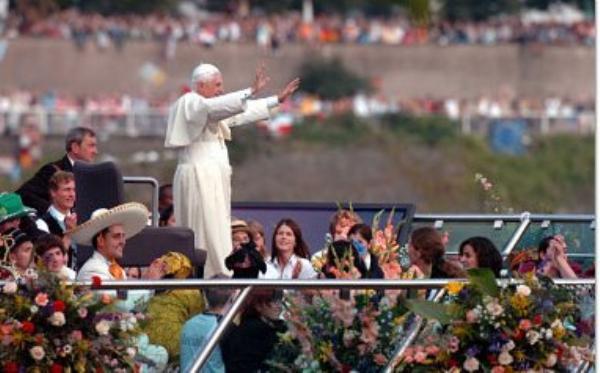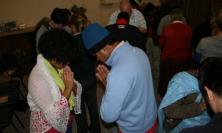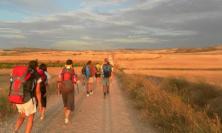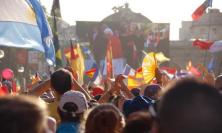Thousands of young Catholics are making their way to Sydney this week for World Youth Day 2008, billed as the largest youth event in the world. But what is it that these young people are going all that way for? From his own experience of four World Youth Days, Chris Docherty explores what is so special about them.
The world is charged with the grandeur of God
I once woke up in a field outside Rome, cold, tired and bewildered. I hadn’t slept very well or for very long. As I crawled out from my sleeping bag and stood up, I saw a sight which changed my outlook on the church and the world forever.
People. Everywhere, from horizon to horizon in a complete circle. Two million young people. Two million people camped out in a giant field in the campus of Tor Vergata University, on the edge of Rome during the World Youth Day in 2000.
Two million people. That’s three times the population of the city of Glasgow, where I live. Twenty Glastonbury concerts placed side by side.
These two million people, in their tents and sleeping bags, covered the land as far as the eye could see, in every direction. It was a truly biblical vision, a sight which inspired me to think again about all my life experience and all the filters through which I examine that experience. I had never seen so many people before in my life. In all my years of youth ministry, talking glibly about “the Church” and “the People of God” or “young people from around the world”, never before had I seen these things with my own eyes in such literal detail.
It changed me much as the Apollo astronauts were changed by seeing the entire planet Earth hanging in space before them as they gazed back from their own Moon-bound perspective. The world is indeed “charged with the grandeur of God”. There are indeed millions of young people who love God and live the gospel and there they were before me, an image still seared onto my retina.
What is World Youth Day?
The first World Youth Day took place in 1985 when Pope John Paul II wrote to young people as part of the UN International Year of Young People. Since then, huge international gatherings have taken place every three years or so in various cities around the world, with annual local gatherings taking place in each diocese on Palm Sunday. It is to the late pontiff’s credit that he saw that young people were increasingly aware of the global contexts of their lives and recognised the need for the Church to offer some kind of global experience of faith and community.
The next World Youth Day takes place next week in Sydney, Australia from Wednesday 9th to Sunday 20th July 2008. An estimated 225,000 young pilgrims will gather from all around the world for prayer, catechesis, liturgy and celebration of their faith. Pope Benedict XVI will join the pilgrims as they reflect on the theme “You will receive power when the Holy Spirit comes upon you and you will be my witnesses” (Acts 1:8).
I was a stranger and you welcomed me
Upon arrival in Australia, pilgrims will be welcomed into family homes for a week to share life and to experience the church at a local level in the families and parishes of Australia.
This “small” experience will provide many challenges and opportunities for us. Most young people will not have had previous experience of accepting hospitality from “strangers”. It invites us to say who we are, to tell stories of where we come from and to reciprocate by learning about a family, a community, a parish and a nation. With support from one another and from their youth pastoral teams, this can build a young person’s confidence and self awareness, as well as enlarging their world-view. In the context of pilgrimage, it allows us to see how faith is lived out in a different culture to our own. By seeing what Catholicism can look, feel and taste like in other places, we can see it more clearly at home, within our own cultures.
The friendships which young people form during experiences like the World Youth Day can be long-lasting and utterly transforming, helping to heal wounds from previous experience and opening up new personal awareness and possibilities for the future. The time spent with one another and the various youth leaders, priests and religious who accompany them is an opportunity to talk, listen and discuss what faith is, who Jesus is, in personal and real terms.
The holy city
In the second week of the pilgrimage, all the pilgrims converge on the Greater Sydney area. Our programme there will involve mornings of catechesis and liturgy and afternoons participating in the Youth Festival.
Bishops from all around the world will lead the catechetical inputs and discussions centred on the pastoral theme of World Youth Day: “You will receive power when the Holy Spirit comes upon you and you will be my witnesses” (Acts 1:8). We will listen to the inputs and discuss them in small groups, before feeding back to the bishop in a Q&A session. The teaching and listening ministry of the bishop is very evident here and the young people are not shy of entering into robust debate with their pastors!
All these discussions, themes and tensions are then gathered together in the Eucharist. Throughout the pilgrimage the tone and style of prayer and liturgy changes between the small and intimate grace before meals, to the contemporary Christian music scene through to the formal elegance and gigantic scale of the papal liturgies.
During the Youth Festival, Sydney will be transformed into an enormous showcase of music, art, drama, seminars, prayer experiences, exhibitions and film hosted by a multitude of nations, campaign organisations, religious congregations, movements and cultural bodies. There will be follow up opportunities, such as gap years, service experiences, social justice programmes and so on, each challenging the pilgrims to grow in solidarity with the poor.
World Youth Day is a deeply urban experience. Pilgrimages and retreats are often situated in quiet, leafy, rural idylls of prayer and contemplation where we discover antidotes to the noise and violence of city life. WYD offers a different template, that of a city transformed. Places of commerce become place of community. Streets of alienation become streets of contemplation. Concrete takes on faith as faith becomes more concrete. Bus stations and subway networks resound to the sound of laughter and song in dozens of different languages. For many of our pilgrims it will be these sensual experiences which remain longest in their memories.
The crescendo of the World Youth Day pilgrimage is an “Easter weekend” with Pope Benedict, beginning with a city-wide Stations of the Cross on Friday 18th July, a walk to Randwick Racecourse on the Saturday for a twilight vigil of prayer, closing with a celebration of the Eucharist on the morning of Sunday 20th. The great challenge of coming home then begins.
A process, not an event
Many people are asking “What is the point of the World Youth Day? Spending all that time and money and energy going around the world for a retreat with the pope?” This point of view tends to see the World Youth Day as an isolated event, full of glitz and noise, which takes place solely within the host nation. Looking at it from that point of view I’d have to agree that there’s little point. I do believe, however, that another perspective is possible, one which requires us to look upon WYD as a process rather than an event.
For me, the value of World Youth Day lies in the process of global pilgrimage. A new phenomenon, the globalisation of travel and communications, meets the very old phenomenon of pilgrimage. With support from the whole faith community, young pilgrims weave the World Youth Day experience into the bigger tapestry of their own lives and their own faith journeys. The point or value of this experience, like any other life experience, emerges in a unique combination of the spectacular and the mundane, the intense and the dull.
Going to see the Pope?
When I first attended World Youth Day with a group in 1997, I was nervous about the apparent focus on the figure of the Pope. I was anxious that our pilgrims would think only of ‘seeing the pope’, or that they might even be hostile to his message. Looking back I can see that I was projecting some of my own fears and prejudices onto them. I had many questions and doubts of my own about the Church’s teaching and Pope John Paul was a deeply ambiguous figure to me: a champion of human rights across the world on one hand, but a severe censor of the same rights in the church on the other. Having grown up to recognise that the church is much more than the priest, that holiness is available to all, I was wary of promoting an image of the church which appeared authoritarian, narrow and intolerant.
The experience then in Paris and latterly in Rome, Toronto and Cologne changed me. I was very moved to see the figure of this old man, passionately trying to share his faith with all these young people, making himself available to them in some sense, and throwing the resources of the Church into a dialogue of faith, hope and love. I recognised that to become fully adult in faith, I needed to enter into this dialogue with the Church, rather than dismissing it out of hand.
I was left with the abiding image of a magnetic compass. When choosing our directions in life, we may not always travel North, where our parents and priests would often like us to go, but we need to know where North is in order to claim our own directions.
If you take time to read any of the World Youth Day letters or homilies, you encounter in Pope John Paul and Pope Benedict patient and gentle witnesses to Christ, who understand that each person grows in faith in a unique, personal way requiring trust, openness and encouragement rather than hectoring, judgment and prohibitions.
The wilderness as a school of faith
Developing this image of compasses and journeys, I see a template for the World Youth Day experience in the story of the Exodus.
In moving from slavery to the wilderness to the promised land, they are accompanied by the Lord in a kind of school of faith-development instigated by God and involving the Law as a design for life. I think this process bears similarity to the journey from childhood to adulthood through adolescence that we all try to make.
When the Hebrews were enslaved in Egypt, they certainly suffered, but they also had a certain security. Slaves, after all don’t need to make many decisions. Childhood can be like this, a time when our needs are taken care of by adults.
Once the newly liberated people are safe from Pharaoh’s army, they are quickly shocked out of their complacency and begin to quarrel and doubt the love of God and the competence of their leaders. They yearn to return to the fleshpots of Egypt. Anyone who has tasted a WYD meal knows the feeling, and I have had many experiences of young pilgrims doubting me and my abilities to look after them, just as Moses did. This time of wandering, wondering and raging can bear a certain resemblance to adolescence.
I believe that one goal of youth ministry is to provide – rather than avoid – experiences of the wilderness. To enter into experiences where young people can re-discover the value of living a life in harmony with God’s dream for them. By the age of 12 or 13 many of our young people say that ‘The Catholic Church’ does not address the nitty-gritty stuff of their lives. The practice of mass-going bores many of them and strangles the vital message of the gospel.
Experiences of pilgrimage such as World Youth Days push young people out of their comfort zones and provide them with a chance to evaluate their lives in fresh contexts. A restricted sense of the spiritual cannot be challenged, stimulated and awakened by further restriction and restraint. In an age ever dominated by screens which both mediate and separate, there is a profound need for earthy, physical, real presences and experiences of faith.
On pilgrimage we discover God in strange and unexpected places, such as ourselves, and we experience prayer that is both personal and communal, on the grandest possible scale. It is a wild place, where the Spirit blows where it wills.
As we make our way to Sydney we can reflect on the ways in which our comfortable lifestyles ‘enslave’ us and the ways in which we need to build community anew. We come to realise together that we are always dependent on God for the good things in our lives, as our forebears in Scripture came to realise, and we can discover a direction for our lives.
When we return to our homes, we will be different and we will have stories to tell. We will need to spend time developing and deepening our understanding of the experience. I think that is true of life generally, a cycle of experience and reflection. The point of World Youth Day is not in Sydney; it is in each one of us.
Our parish communities expect us to return renewed in Spirit and energised to serve God’s people. We will have gone all the way around the world in order to come home to our selves.
We shall not cease from exploration
And the end of all our exploring
Will be to arrive where we started
And know the place for the first time.
(from Little Gidding by T.S. Eliot)
Chris Docherty is Youth Officer for the Archdiocese of Glasgow.






